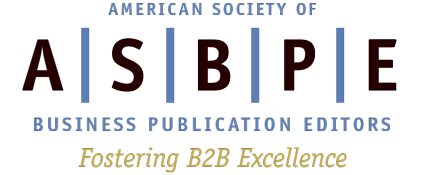Note: This is the first in a series of 2020 posts from the ASBPE Ethics Committee.

Conferences and trade shows are a growing source of revenue for business-to-business magazines and newsletters. For writers and editors at the publications that run them, the events can be a double-edged sword. The meetings can offer journalists unmatched access to participating speakers and vendors, but they also pose ethical quandaries that, if not managed properly, can prove damaging to the publication’s brand reputation. Here are suggestions for dealing with four common scenarios.
• Handling meeting requests. As a reporter covering your own publication’s conference, you may feel compelled to agree to a meeting request from an exhibitor or the exhibitor’s sales manager. The pressure can be particularly intense if, say, the conference’s organizers drop not-so-subtle hints that you would do well to accept.
Gathering for a friendly meet-and-greet with these folks at an opportune time is fine, but boundaries need to be established around additional requests that may encroach on your publication’s editorial priorities and independence. There’s little harm — and perhaps much value — in learning about the products and services being showcased. But, when appropriate, make clear to the exhibitor or sales manager that the information gathered will be judged for coverage purposes against the publication’s editorial standards regarding newsworthiness, space considerations or other criteria.
• Covering the expo floor. A hazard of show coverage when the event is your own is the prospect of favoring or upsetting the largest exhibitors. Maintaining objectivity without running afoul of their expectations respecting editorial might seem a tall order.
One way to deal with the dilemma: Offer the exhibitors and advertorial or sponsored content in a conference buyers’ guide, show daily or other supplemental media. So long as the editorial team indicates that that content is paid for — and in a way that it can’t be confused with regular editorial — then that should resolve the issue. As needed, hire freelancers to do the reporting so the publication’s staff can devote themselves fully to editorial priorities.
If, however, the exhibitors press for coverage in your magazine or newsletter, then communicate that they’re asking you to cross a red line that’s in neither their interest nor yours. Make clear (diplomatically) that coverage about them and their offerings risks being devalued if the reporting is perceived as compromised. Your publication’s hard-earned brand reputation will be tarnished, and you’ll ultimately lose readers — the very people that the exhibitors are trying to sell to.
• Crossing the line into boosterism. An ever-present danger of show reporting is that vendors’ enthusiasm for their latest rollouts — particularly those powered by new technologies — will seep into your conference coverage. The temptation to veer from a more appropriately neutral tone in reporting is all the greater when your publisher is hosting the event — and hoping to lure back the same vendors for next year’s gathering.
Whenever possible, do advance reporting on topics you expect to cover at the conference, taking care to reach out to consultants, researchers or others who can provide an independent voice — and a sanity check — on claims by those exhibiting or presenting at the event. Alternatively, strive to build in value-added coverage separate from what’s on the agenda.
Too often, reporters simply recap talking point of speakers presenting at general or breakout sessions. You can gain more critical and insightful perspectives about what’s happening inside your industry by arranging exclusive Q&As with industry movers-and-shakers, regulators and individuals holding positions further down the food chain. Another option: hosting a round-table discussion with key industry players on topics that are top-of-mind at the conference.
• Deciding which sessions to cover and speakers to interview. As so often happens, reporters navigate to sessions where the speaker(s) and topics are expected to be big draws for attendees. If the individual presenting is a CEO or senior executive of a company that’s also exhibiting at your conference, you may deem coverage of the session all but a requirement if you’re to stay in the exhibitor’s — and your publisher’s — good graces.
Resist the urge to do so. Your show reporting should ultimately be guided by what’s going to deliver the most value to the readership. That may entail focusing on sessions where the content covers subjects or trends your publication hasn’t previously explored. It may also dictate bundling together comments from different presenters, and from speakers and attendees outside the sessions, to build out a narrowly focused story theme.
Your Go-To Reference Guide
Are you facing another issue that might conflict with your publication’s editorial mission? Check out ASBPE’s Guide to Best Practices. Revised in 2013, the nearly 7,000-word document provides guidance for dealing with myriad issues, from social media and graphics to conflicts of interest and, yes, covering trade shows and conferences.
You’re welcome also to connect with ASBPE’s Ethics Committee, led by JD Solomon. Just drop us a line!
Warren S. Hersch is an associate editor at Life Annuity Specialist, a Money-Media and Financial Times Co. publication. He is also a member of ASBPE’s national board and co-president of the society’s New York chapter.
